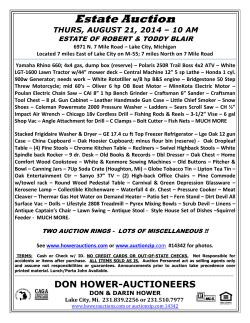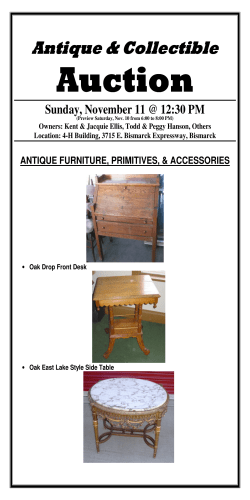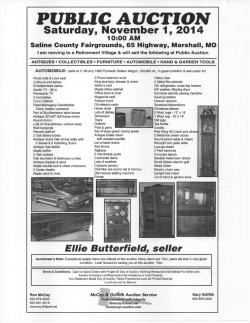
Medal of Honor Memorial Trees
Medal of Honor Memorial Trees Ü 2 m n 1 m n 3 m n 7 m n 8 m n 4 m n McPhe rs on D r 6 m n 5 m n 9 m n 10 m n Section 2 ils o nD r 11 m n 12 m n W Section 13 15 m n Section 37 13 m n 14 m n 16 m n 17 m n 31 m n 33 m n 35 m n 32 n 34 m m n 36 m n Section 23 28 m n 30 m n 29 m n 26 m n 25 n 27 m m n 24 m n 23 m n Section 24 18 m n 19 m n 20 21 m n m n u Farrag t Dr 22 m n Section 46 MEMORIAL TREES AT ARLINGTON NATIONAL CEMETERY Medal of Honor Recipients There are 36 Memorial Trees located in Arlington National Cemetery as a living tribute to the nation’s Medal of Honor recipients. Each tree is a descendent of the historic trees listed below. TREE #1, Section 2, near the Kearny Monument: Martin Luther King, Jr. Water Oak The Martin Luther King Jr. Water Oak is part of a grove of water oaks located next to the Brown Chapel African Methodist Episcopal Church, located in Selma, Ala. Gathering under the shade of these trees, people listened to the Reverend Martin Luther King, Jr. speak before a 50-mile march to Montgomery in support of the bus boycott, a movement begun by Rosa Parks in 1955. TREE #2, Section 2, near the Kearny Monument: National Champion Crape Myrtle In 1920, Hattie Neal, daughter of Captain John Neal, dug a small crape myrtle tree from the yard of relatives in Paris, Ky. and planted it in the front yard of her family’s home in McIntosh, Fla. Since 1920, Hattie Neal's crape myrtle has grown to become the National Champion Crape Myrtle — the largest of its species in the nation. TREE #3, Section 2, near the Kearny Monument: Robert E. Lee Sweetgum Sweetgum trees were plentiful around Stratford Hall, the Westmoreland, Va., plantation that was home to four generations of Lees, among them Richard Henry Lee and Francis "Lightfoot" Lee, the only brothers to sign the Declaration of Independence, and Robert E. Lee, the commander-in-chief of the Confederate Army. TREE #4, Section 13, near Memorial Section G: Ute Council Cottonwood Chief Ouray was a well educated and powerful Native American speaker who promoted peace between the Utes tribe and white settlers. After the Meeker massacre in September 1879, he traveled to Washington, D.C. to plead the Utes' cause. The Cottonwood tree, located in Delta, Colo, shaded the peace meetings between the Utes and settlers. TREE #5, Section 13, near Memorial Section G: Charter Oak The Charter Oak was the most well-known and celebrated tree in Connecticut, estimated to have been between 800 and 1000 years old, before falling during a storm. This tree is a generation descendant of the original old white oak, considered by many to be a symbol of the spirit of American independence and of the colonists' quest for freedom from oppression. TREE #6, Section 13, near Memorial Section G: Nathan Hale Northern Red Oak Nathan Hale was a captain in the Continental Army during the Revolutionary War. After his capture by the British and confession of being a spy, he was hanged, purportedly utterly the now famous words, "I only regret that I have but one life to lose for my country." The red oak shaded his childhood home. TREE #7, Section 2, near the Kearny Monument: Tidal Basin Japanese Cherry In 1909, Japanese Emperor Mutsuhito and the Tokyo Municipal Council gifted 2,000 Japanese Cherry Tree saplings to America. Unfortunately, the original trees did not survive. When the second shipment of 3,000 saplings arrived two years later, Helen Herron Taft, wife of President William Taft, along with the Japanese Ambassador’s wife, planted the first two trees on March 29, 1912. Both the president and his wife are buried at Arlington in section 30. TREE #8, Section 2, near the Kearny Monument: Columbus White Oak Named for the Christopher Columbus, the man who spent years of his life charting the New World, the Columbus White Oak in New Hope, Pa., is estimated to be more than 500 years old. TREE #9, Section 2, near the Kearny Monument: Jesse Owens Water Oak A member of the U.S. track team in the 1936 Olympic Games, Jesse Owens became the first American to win three Olympic events. Later in life, he played an active role in youth athletic programs and in 1952 became secretary of the Illinois Athletic Commission. The white oak is located at Owens’ boyhood home in Danville, Ala. TREE #10, Section 2, near the Kearny Monument: Helen Keller Water Oak When Helen Keller, who was both blind and deaf, was seven years old, Anne Sullivan, a graduate of The Perkins School for the Blind, began the extraordinary task of teaching her to communicate. In her book, "The Story of My Life," Keller recalls her study of nature by climbing trees in the yard of her home. While the exact tree remains a mystery, the more than 100-year-old Helen Keller Water Oak is believed to be the one she recalled. TREE #11, Section 13, near gravesite MG-14: President Dwight D. Eisenhower Sycamore In 1953, Dwight D. Eisenhower was elected the 34th President of the United States and was the first president to become a licensed pilot, appear on color television, and serve two terms as mandated by law. In 1961, Eisenhower and his wife retired to Gettysburg, Pa., where sycamores shaded their farm. TREE #12, Section 13, near gravesite MG-80: Abe Lincoln Overcup Oak In 1861, Abraham Lincoln was elected the 16th President of the United States and served during the Civil War, arguably the most divisive time in American history. Lincoln is credited with preserving the union of the United States. This tree is a descendent of the oak that shaded the Hardin County, Ky., home where Lincoln was born. TREE #13, Section 37, near gravesite 158: Antietam Sycamore The Antietam Sycamore stands in silent honor of the more than 23,000 lives lost in the Civil War battle of Antietam. It stands at the end of Burnside Bridge, where Union troops forced a crossing against the Confederate troops. TREE #14, Section 37, near gravesite 83: Gettysburg American Sycamore For three days beginning on July 1, 1863, three American Sycamores stood witness as Union and Confederate armies fought at Gettysburg, Pa. Four months later, President Abraham Lincoln delivered a short speech, that became known as the Gettysburg Address, at the dedication of the Soldiers’ National Cemetery. TREE #15, Section 13, near gravesite 908-1-A: Walden Woods Red Maple This Walden Woods Red Maple has been grown from seeds of trees descended from those that shaded Henry David Thoreau’s Walden Pond as part of the effort to preserve the Walden Woods for future generations. TREE #16, Section 37, near gravesite 16: Henry Ford Estate Sycamore In 1908, Henry Ford gained world attention with the Model T, the first mass-produced automobile in the world. Ford and his wife later sought privacy and solitude on more than 1,000 wooded acres outside Detroit on the Rouge River. This tree is a descendent of the sycamores located on the property. TREE #17, Section 13, near gravesite 14673-2: Charles Lindberg Red Maple Charles A. Lindberg grew up in Little Falls, Minn. and is most remembered for his solo flight across the Atlantic Ocean from May 20 to 21, 1927. The Charles Lindberg Red Maple stands at his boyhood home in Little Falls. TREE# 18, Section 37, near gravesite 3906-1: Champion Hill Southern Magnolia In the spring of 1863, Union General Ulysses S. Grant launched a campaign to seize the Confederate bastion of Vicksburg on the Mississippi River. The battle took place at Champion Hill, where Confederate forces were driven back toward the defenses of Vicksburg. After a siege of more than a month, Vicksburg fell to Union troops. The Champion Hill Southern Magnolias stood in the yard of the Coker House near Champion Hill. TREE #19, Section 37, near gravesite 3906-1: George Washington Carver Green Ash George Washington Carver was one of the country’s leading scientists who spent the early part of his life as a slave. The tree was grown from seeds collected from the Tuskegee Institute at the National Memorial in Diamond, Mo., where Carver invented 325 products made from peanuts, 118 from sweet potatoes, and many others from wood shavings and other native Southern agricultural products. TREE #20, Section 37, near gravesite 3956: Lewis and Clark Cottonwood On the evening of July 25, 1806, Meriwether Lewis and William Clark camped under trees near Cut Bank, Mont., with eight Blackfoot scouts. During a scuffle that night, two of the scouts were killed. The Lewis and Clark Cottonwood stands on the site of the encounter which began much hostility between white settlers and native tribes in the area. TREE #21, Section 37, near gravesite 3949: Fort Atkinson Black Locust In 1804, Lewis and Clark met with members of the Missouri and Ohio tribes at a place they named Council Bluff. Fifteen years later, a fort commanded by Col. Henry Atkinson was established at the site. In 1823, the fort's second commander, Col. Henry H. Leavenworth, planted a grove of black locust trees at the fort. Today, those trees are located at Fort Atkinson Historical Park, Fort Calhoun, Neb. TREE #22, Section 46, near gravesite 1379: Washington Crossing Sycamore Maple The Washington Crossing Sycamore Maple witnessed George Washington’s famous Delaware River crossing in 1776. TREE #23, Section 24, near gravesite 15751: Guilford Courthouse White Oak The Guilford Courthouse White Oak, located in North Carolina, stood witness to the fighting between colonists and the British during the Revolutionary War in 1781. TREE #24, Section 13, near gravesite 14338-1: Montpelier Pignut Hickory The Montpelier Pignut Hickory shaded President James Madison’s Montpelier, his estate in Orange County, Va. In addition to serving as president for two terms, he played a significant role in the development of the Constitution and the Bill of Rights. TREE #25, Section 24, near gravesite 15765: Independence Hall Black Locust The Independence Hall Black Locust located at the entrance of the Independence Hall in Philadelphia, Pa., is a living witness to significant events in American history, including the meeting of the Second Continental Congress, the signing of the Declaration of Independence, and the writing of the Constitution of the United States. TREE #26, Section 13, near gravesite 14150-2: Haines Apple The Haines family was one of the earliest to settle in the Rogue River Valley of southwestern Oregon. An apple tree marks the site of the Haines cabin, built around the time of the Civil War. TREE #27, Section 23, near gravesite 22716: Lafayette Sycamore The 111-foot Lafayette Sycamore is located in the Brandywine Battlefield Park in Chadds Ford, Pa. The tree was already 168 years old when it sheltered the troops led by Generals George Washington and Marquis de Lafayette in the battle of Brandywine in 1777. TREE #28, Section 13, near gravesite 14067: First Delicious Apple In the 1870s, Jesse Hiatt was a hard-working Iowa pioneer who lived with his wife and ten children in a two-room farmhouse. One day, he noticed a chance seedling in his orchard. He kept watch over it, and about six years later, it produced its first apple named the "Delicious". Today, an offspring of the original tree grows on a farm near Winterset, Iowa. TREE#29, Section 23, near gravesite 22229: Woodrow Wilson Red Oak Woodrow Wilson was an author, scholar, university president, governor, and Nobel Peace Prize recipient in addition to being president. Despite popular opinion against U.S. involvement in the "European War," Wilson was forced to declare war when Germany sank four American ships. In 1918, he issued his "Fourteen Points," intended to bring peace to the world. TREE #30, Section 23, near gravesite 21979: Harriet Beecher Stowe White Ash Harriet Beecher Stowe, one of America's greatest novelists, was also an ardent opponent of slavery. Stowe is most remembered for her indictment of slavery in "Uncle Tom's Cabin, or Life Among the Lowly," which was published in 1852 and sold more than 500,000 copies in its first five years. This White Ash has been grown from seeds collected at Stowe’s birthplace in Hartford, Conn. TREE #31, Section 13, near gravesite 13856: Fort Ticonderoga Green Ash The French built Fort Ticonderoga, first known as Carillon, in 1755 at the outset of the Seven Years' War to block the British presence on Lake Champlain, a strategic site on the New York-Vermont border. In 1759, Lord Jeffery Amherst overcame the French garrison and renamed it Ticonderoga. On May 10, 1775, at the outset of the Revolutionary War, Ethan Allen and Benedict Arnold took the fort from the British, giving the Colonies their first victory. The Fort Ticonderoga Green Ash shades the banks of Lake George, N.Y. TREE #32, Section 23, near gravesite 16850: Patrick Henry Osage Orange The National Champion Patrick Henry Osage Orange is more than 400 years old and is the focal point of the grounds at Virginia's Red Hill, Henry's home and resting place. Best known for his "give me liberty or give me death" speech, Patrick Henry has been called the "Voice of the American Revolution" for his insistence on individual freedoms under the Constitution and his instrumental efforts in the adoption of the Bill of Rights. TREE #33, Section 13, near gravesite 13820: George Washington American Holly After George Washington's years of service to his country were over, he returned to his beloved Mount Vernon estate, where landscaping and gardening were his primary daily activities. In 1792, he established an area specifically for "any and all kinds of plants fit for hedging," according to his journal entries. The George Washington American Holly is grown from seeds gathered at Mount Vernon. TREE #34, Section 23, near gravesite 16687: Pringle Sycamore The Pringle Tree is located on the site of the first permanent settlement west of the Alleghenies in Virginia. The tree, a large hollow sycamore, is the third generation of a still larger hollow sycamore that provided a shelter for two deserters from Fort Pitt —John and Samuel Pringle — from 1764 to 1767. TREE #35, Section 13, near gravesite 13745: Eleanor Roosevelt White Ash Anna Eleanor Roosevelt was married to President Franklin D. Roosevelt and held many positions in her life including chairman of the Democratic Public Service committee, assistant director of the Office of Civil Defense, and U.S. Representative to the United Nations General Assembly and chairman of its Human Rights Commission. This tree shaded her home in Hyde Park, N.Y. TREE #36, Section 23, near gravesite 16569: Minuteman Red Maple When British soldiers marched to Lexington, Mass., on the morning of April 19, 1775, they were faced by local militiamen sworn to be "ready in a minute" to resist Redcoat rule. A shot was fired, starting the American Revolution. The Minuteman Red Maple is located in the National Historical Park in Concord, Mass.
© Copyright 2025









